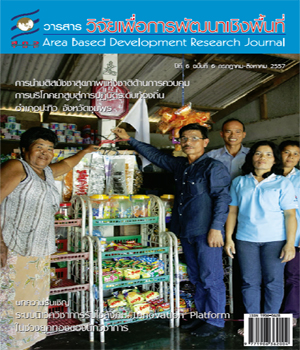การพัฒนาหลักสูตรโรงเรียนต้นน้ำ เพื่อการอนุรักษ์พื้นที่ลุ่มน้ำชุมชนอย่างมีส่วนร่วมของท้องถิ่น : กรณีศึกษาลุ่มน้ำยมตอนบน (ปีที่ 1)
Main Article Content
Abstract
งานวิจัยนี้เป็นการวิจัยและพัฒนาที่ใช้ระเบียบวิธีวิจัยเชิงปฏิบัติการแบบมีส่วนร่วม(Participatory Action Research: PAR) เพื่อสร้างแม่แบบการเรียนรู้ด้านการอนุรักษ์ทรัพยากรป่าไม้ ต้นน้ำลำธารในพื้นที่ชุมชนของตนเอง และสร้างความตระหนักด้านการรักษาทรัพยากรธรรมชาติแก่เยาวชนในท้องถิ่น ดำเนินการวิจัยตั้งแต่ กรกฏาคม 2555 - มิถุนายน 2556 กลุ่มตัวอย่างในการศึกษา ได้แก่ 1) กลุ่ม “โรงเรียน” คือ ครู 15 คนจาก 9 โรงเรียน ศึกษานิเทศก์สำนักงานเขตพื้นที่การศึกษาประถมศึกษาพะเยาเขต 2 และอดีตนักวิชาการศึกษา 2) กลุ่ม “บ้าน” ประกอบด้วย ผู้รู้ท้องถิ่น ได้แก่ ประธานป่าชุมชนบ้านหนุน เจ้าหน้าที่หน่วยศึกษาการพัฒนาการอนุรักษ์ต้นน้ำม่าว เจ้าหน้าที่สถานีศึกษาภูมิอากาศป่าไม้ลุ่มน้ำยม ผู้ใหญ่บ้านและผู้ช่วยผู้ใหญ่บ้าน และ นายกเทศมนตรีเทศบาลตำบลปง และ 3) กลุ่ม “วัด” ได้แก่ เจ้าอาวาสวัดพระธาตุดอยหยวก และพระเฉลิมชัย โชติธัมโม จากอารามหลวงวัดศรีโคมคำจังหวัดพะเยา เครื่องมือวิจัยประกอบด้วย การจัดเวทีระดมความคิดเห็นจาก บ้าน วัด และโรงเรียน (บวร) เพื่อหารูปแบบของหลักสูตร การสำรวจเพื่อค้นหาภูมิปัญญาท้องถิ่นด้านการจัดการทรัพยากรธรรมชาติจากผู้รู้โดยสุ่มอย่างเจาะจงด้วยเทคนิคสโนวบอล (Snowball sampling) การประชุมเชิงปฏิบัติการเพื่อวิพากษ์หลักสูตร การติดตามและประเมินผลการเรียนรู้ประกอบด้วย การทดสอบก่อนและหลังเรียนกับนักเรียนโรงเรียนบ้านหนุน ระดับชั้นประถมศึกษาปีที่ 4-6 และการประชุมเชิงปฏิบัติการเพื่อรวบรวมความคิดเห็นหลังเสร็จสิ้นโครงการข้อมูลเชิงคุณภาพวิเคราะห์จากเนื้อหาหลักสูตร สาระจากการประชุมเชิงปฏิบัติการ และจากการสำรวจภูมิปัญญาท้องถิ่นนำเสนอผลด้วยการพรรณนา ส่วนข้อมูลเชิงปริมาณจากผลการทดสอบก่อนและหลังเรียน วิเคราะห์ด้วยสถิติพื้นฐาน ได้แก่ ค่าเฉลี่ย (mean) ของคะแนน
ข้อค้นพบจากงานวิจัยที่สำคัญมีดังนี้ 1) ออกแบบหลักสูตรโรงเรียนต้นน้ำที่ผสานความรู้สากลกับความรู้ภูมิปัญญาท้องถิ่น ประกอบด้วย 6 หน่วยการเรียนรู้สำหรับนักเรียนชั้นประถมศึกษาปีที่ 4-6 (รหัสรายวิชา ว 14201 15201 และ 16201 ตามลำดับ) โดยหน่วยการเรียนรู้ที่ 1-4 ให้ความรู้ด้านธรรมชาติวิทยา ส่วนหน่วยการเรียนรู้ที่ 5 และ 6 ให้ผู้เรียนเข้าใจการใช้ประโยชน์ทรัพยากรป่าไม้ตามแนวทางภูมิปัญญาท้องถิ่น 2) ค้นพบภูมิปัญญาเด่น คือ การสร้างฝายไม้ตอกหลักอายุ 200 ปี ณ หมู่บ้านน้ำปุก เป็นมรดกทางภูมิปัญญาล้านนาด้านระบบเหมืองฝาย ที่ใช้จัดสรรน้ำอย่างเป็นธรรมแต่ไม่ทำลายระบบนิเวศ 3) ผลการทดลองใช้เนื้อหาบางส่วนของหลักสูตร พบว่า ผลสัมฤทธิ์ด้านความรู้ความเข้าใจเนื้อหาหลังเรียนสูงกว่าก่อนเรียนมากกว่า 15% และทุกชั้นปีผ่านเกณฑ์การเรียนรู้ที่กำหนดไว้ที่ 75% ได้บรรจุหลักสูตรโรงเรียนต้นน้ำในสาระการเรียนรู้เพิ่มเติมวิชาวิทยาศาสตร์และนักเรียนที่ผ่านหลักสูตรนี้มีทักษะทางวิทยาศาสตร์สูงขึ้น ผลการวิจัยทำให้ชุมชน เยาวชน และ วัด ค่อยๆ ซึมซับแนวคิดด้านการอนุรักษ์ทรัพยากรป่าไม้และมีโครงการประกาศเขต “ป่าชุมชนบ้านดง” ซึ่งอยู่ติดกับป่าชุมชนบ้านหนุน ส่งผลให้กลุ่มเยาวชนได้ตระหนักด้านการรักษาทรัพยากรป่าไม้ยิ่งขึ้น
Development of a Curriculum for a Watershed School as a Method to Conserve a Watershed area based on the Local Community Participation : the Case Study of the Upper Part of Yom River Basin (1st year)
This research and development was mainly conducted by using the approach called Participatory Action Research (PAR). The project aimed to create a template of a learning course concerning forest and watershed conservation in the local community as well as raise an awareness among local children to preserve their natural resources. The project was undertaken from July 2012-June 2013. The samples include 1) “School” group consisting of 15 teachers from 9 schools, educational supervisors from Phayao Primary Educational Service Area Office 2 and a former educator 2) “Home” group comprising of those local wise men which were a chair of Ban Noon community forest committee, headman and vice-headman of the village and mayor of Pong municipal district and 3) “Temple” group consisting of the abbot of Phra-Tat Doi Hyok temple and Phra Chalermchai Chotidhamo from the royal monastery, Sri Khom Kham, Phayao province. Several tools were used here in this research ranging from brainstorming of the 3 major groups of the community: home, temple and school (HTS) to approve the outline of a newly developed curriculum, surveying to search for local wisdom in relation to natural resource management from local wise men who were selected purposively by snowball sampling, organizing workshops to criticize the ongoing curriculum, assessing and evaluating the curriculum by conducting a pre-post test on Ban-Noon students grade 4-6 and meeting to summarize the project outcome. Qualitative data from the content of the curriculum, data from each workshop and local wisdom records were subjected to descriptive analysis while quantitative data from pre-post tests was calculated by a simple means of data.
The major findings from this project are 1) the curriculum developed here was designed to include both natural sciences and local wisdom in its content which could be divided into 6 units intended for teaching students grade 4-6 (subject codes Sc 14201, 15201 and 16201, respectively). For those 6 units, unit 1-4 teaches modern natural sciences and unit 5 and 6 provides insight into the utilization of forest according to local wisdom. 2) From our survey, we found an outstanding local knowledge, a 200 year-old wooden check damn at Nam-Puk village. It is a legacy of Lanna knowledge on irrigation system which effectively distributes fair amount of water but minimally disturbs the ecosystem. 3) The result of preliminary implementation on some parts of the curriculum judged by achievement test clearly showed that after taking the class, students could score >15% higher than did before taking a lesson. Also students in every grade had passed the standard which was set at 75%. The curriculum for watershed school here was used as a supplementary curriculum for sciences subject and students who passed this curriculum showed higher scientific skills. The outcome of this project caused the community children and monks to gradually absorb the ideology toward conservation of the forest resources as well as initiated the declaration of “Ban Dong community forest” which located in proximate to those of Ban Noon. All of these results surely enhanced awareness among local children and induced them to preserve the forest resources.
Article Details
Area Based Development Research Journal values copyright protection and licensing to safeguard author rights and facilitate the appropriate dissemination of research. Our policies ensure openness, accessibility, and attribution. Authors retain copyright ownership, and articles are published under a Creative Commons Attribution License (CC BY), allowing sharing, adaptation, and proper attribution. Authors have the freedom to publish under the CC BY license, granting broad reuse and distribution permissions. The journal supports posting articles on third-party repositories, adhering to institutional and funding restrictions. Author guidelines detail copyright and licensing requirements, empowering authors with knowledge about their rights and responsibilities. These policies cultivate an environment of collaboration, openness, and responsible sharing, benefiting authors and the research community while honoring intellectual property rights.


